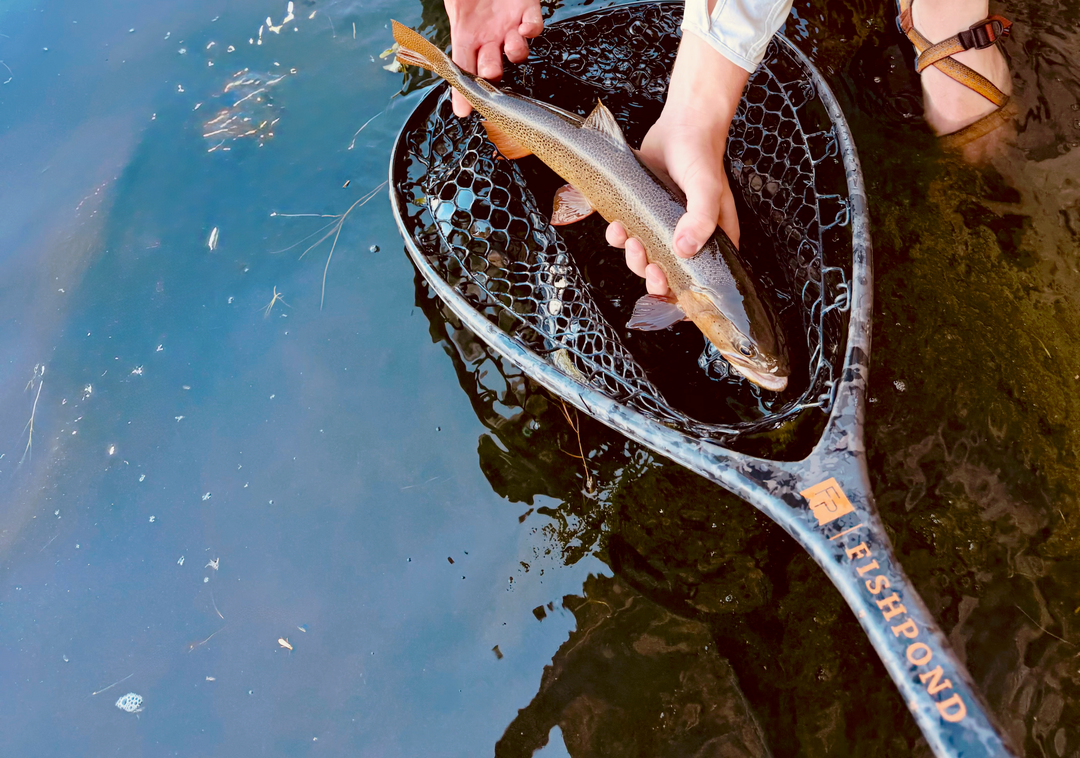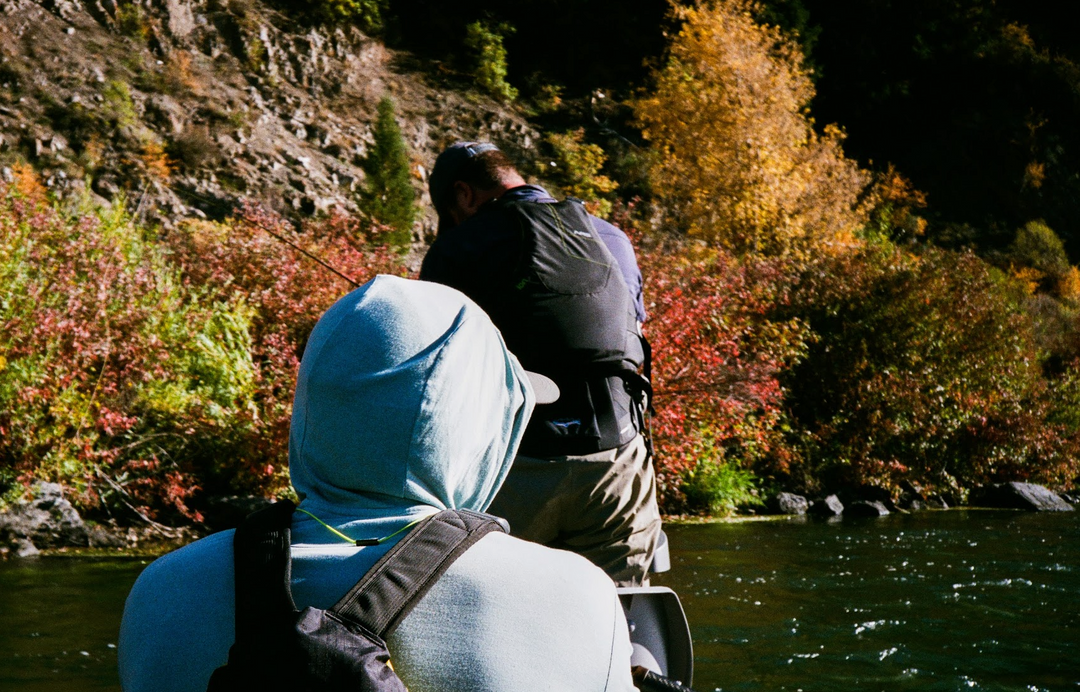Why You Should Wade When You Have a Fishing Boat
Owning a boat is one of the great milestones in an angler’s journey. Whether it’s a small aluminum jon boat passed down from your grandpa, a handcrafted wooden dory you built yourself in your garage, or a lightweight raft, the feeling is the same — freedom. With a boat you suddenly can float all different types of rivers and make the rivers you frequent more accessible. You can float miles in an afternoon, fish stretches that once felt out of reach, and cover more water than you ever imagined when you were stuck on shore. Boats are expensive, but they are simply one of the best pieces of fishing gear you can own.
So once you’ve made that leap, it’s natural to think you’ll never need to wade again. Why pick apart a couple runs on foot on a packed Saturday when you could slide downstream, grab a buddy and some rods, and hit miles of river in the same time? Why settle for less when you’ve invested in more?
I get it. Fishing from a boat is fun. It’s efficient. It’s social. Fishing from a raft specifically can open up entire worlds of water that a drift boat, float tube, canoe, or kayak can’t touch. But here’s the truth: even if you own a boat, you shouldn’t stop wading. In fact, keeping your walk-and-wade skills sharp may be the single best way to use your fishing effort to grow as an angler.
This isn’t just about nostalgia or “earning it the hard way.” To effectively wade in most rivers it requires you to slow down, notice details, and truly understand rivers in ways that drifting past them never can. It’s a training ground where you refine fundamentals, develop instincts, and practice repetition. And when you bring those sharpened skills back to the boat, you fish better, cast smarter, and row with more intention.
So let’s break down exactly why wading still matters — and why you’ll actually become a more complete angler if you keep walking into rivers even after you’ve bought a boat.
Wading Sharpens Your Fundamentals

A drift boat or raft is a powerful tool, and a skilled rower can make you look like a better angler than you really are. They position you perfectly, hold you off a seam, slow the drift, and even line you up for the ideal shot. When you spend a lot of time fishing from boats, it’s easy to lean on those advantages without realizing how much work the rower is doing behind the scenes.
But when you wade, that safety net disappears. Suddenly, every fish you catch is the direct result of your own positioning, your own cast, and your own presentation. You don’t have oars correcting your mistakes — you have to solve them yourself.
That forces you to focus on fundamentals:
-
Approach: You learn how to wade quietly, using the current to mask your steps and avoid sending out pressure waves that spook fish. You pay attention to light, shadows, and how your profile looks against the bank.
-
Casting: Without a rower setting you up, you’re often stuck with less-than-perfect angles. That means developing a strong roll cast, practicing reach casts in tight quarters, and finding creative ways to deliver flies into tricky spots.
-
Presentation: When repositioning isn’t easy, you’re forced to maximize the shots you have. That pressure teaches you how to mend quickly, drop slack where you need it, and keep flies drifting naturally even in awkward currents.
When you hone those fundamentals on foot, they stick with you. Then, when you’re back in a boat, you’re no longer just a passenger benefiting from good rowing. You’re a sharper caster, a more self-reliant angler, and someone who can make the most of each opportunity.
Wading Teaches You to Read Water

Boats are incredible for covering distance. You can launch in the morning, float ten miles of river, and never fish the same spot twice. But that efficiency has a downside: you rarely get to truly dissect water.
Think about it. When you’re floating, the current is always moving you downstream. You may get one or two casts into a seam, a drift along a bank, and then it’s gone. By the time you’ve worked out the right line speed or drift angle, the spot is thirty feet behind you.
Wading flips that equation. On foot, you can’t cover miles of water in a day. You’re forced to slow down and fish what’s in front of you thoroughly. You notice micro-currents that split around submerged rocks. You feel how depth shifts under your feet, revealing softer seams. You start to see why trout hold where they do — because you’re literally standing in the same current they are.
This slower pace lets you practice in ways that drifting past never could. Want to work on your reach cast? You can throw it at the same seam twenty times until it looks right. Want to learn how fish respond to small mends or different drifts? Stay in one run and test variations until you see how trout react.
Those repetitions build instincts. Soon, when you’re back in the boat, you’ll glance at a bank and immediately recognize the fishy spots. You’ll know when to drop your cast upstream, when to tuck it behind structure, and how to mend before drag sets in. Reading water becomes second nature — and that makes you far more effective from the deck of a raft.
Wading Expands Where You Can Fish

One of the biggest misconceptions about owning a boat is that it solves access completely. Yes, boats open up huge rivers, reservoirs, and sections of water you could never reach otherwise. But there are just as many situations where a boat is the wrong tool.
Think about low water years. A raft can float in surprisingly skinny conditions, but eventually flows drop too far. Yet that’s often when fish concentrate in the deepest slots, making wading phenomenal.
Or consider side channels and braided rivers. Some of the best lies are tucked away in water too narrow or log-choked for a vessel to pass through. If you rely on your boat exclusively, you’ll drift right by them.
Then there’s runoff season. Main rivers may be blown out, unfishable from both shore and boat. But this is the perfect time to hike into small river tributaries or alpine lakes, where water runs clear and small fish think they're a tuna with how aggressive they eat. Those opportunities belong entirely to the wade angler.
In short: a boat may open doors, but wading still provides versatility. It ensures you’re not limited by conditions or water type. The best anglers use both, knowing when to float and when to ditch the boat and fish on foot.
Wading Builds Casting Skill Through Repetition

Casting is one of those skills that everyone thinks they’re decent at — until they’re tested. In a boat, you can get away with a lot of flaws because a rower sets you up for the perfect angle. On foot, you don’t have that luxury.
And here’s the kicker: boats don’t give you much practice. You only get one or two shots at a piece of water before you drift past. By the time you adjust your timing or line speed, you’re already downstream.
When wading, you can stay in one spot as long as you want. You can practice dropping a dry fly on the soft inside edge of an eddy until you nail it. You can work on tuck casts into pocket water, repeating the motion until it’s consistent. You can refine your reach cast to get a drag-free drift across tricky seams.
This repetition is how casting actually improves. It’s not about one perfect fishy cast — it’s about throwing the same cast dozens of times until it becomes muscle memory. Then, when you’re back in a boat, you don’t need ten tries to get it right. You’ve already built the mechanics on foot.
I saw this firsthand on a recent trip to the Green River in Utah with my father-in-law. He’s relatively new to fly fishing, and in two days of wading his casting improved dramatically. The next time we fish from a raft, I’m confident he’ll catch more fish for no other reason than his ability to put the fly where it needs to be, consistently. Wading gave him the space and repetition to practice — something a fast-moving drift never would have allowed.
Wading Keeps You Connected (and Independent)

Beyond the skill development, wading simply offers benefits that boats can’t match.
First, it builds self-reliance. Not every trip goes as planned. Flows change, ramps close, weather shifts. If you’re confident on foot, you can still fish productively without a vessel. You’re not dependent on the oars or on someone else rowing you into position.
Second, wading is often more accessible for families or newcomers. Not everyone has the space for a trailer, the storage for a raft, or the budget for a drift boat. But anyone can grab a rod and fish from shore. Teaching kids to wade into a shallow run is often safer and easier than managing them in a boat.
Finally, wading fosters a deeper connection to the river. You’re literally standing in the current, feeling how seams converge, noticing insects hatching at your knees, and becoming part of the environment in a way you can’t from a deck. Some of my most vivid fishing memories come from being waist-deep in cold water at dusk, surrounded by rising fish, with no boat in sight.
That connection matters. It’s not just about catching fish — it’s about understanding rivers intimately and appreciating the details that make them alive. Boats are incredible tools, but they can create distance between you and the water. Wading bridges that gap.
Balance Matters: Fishing in Boats and Wading

Fishing from boats is one of the great joys of angling. They expand your horizons, make water more accessible, and allow you to cover miles in a single day. But don’t make the mistake of giving up walk-and-wade entirely.
Wading keeps your fundamentals sharp, teaches you patience, and forces you to own every detail of your cast and presentation. It slows you down, helps you read water more deeply, and gives you the repetition needed to truly improve. It opens up side channels, tributaries, and skinny runs that boats can’t touch. And perhaps most importantly, it keeps you connected — both to the river and to your own development as an angler.
The best fishermen I know don’t choose one over the other. They blend both. Wading teaches detail; boats teach efficiency. Together, they make you complete.
So yes, enjoy your boat. Load it up with rods and gear, tow it to new rivers, and cover water that once felt out of reach. But also grab your waders, walk into that side channel on your favorite fishing grounds, and spend an afternoon picking apart all the features on one 100 yard stretch.
These two seemingly different "disciplines", fishing in boats vs wading, feed your development as an angler and they also can fuel the success of the other when each is practiced. This is one of the reasons this sport is endlessly rewarding.





